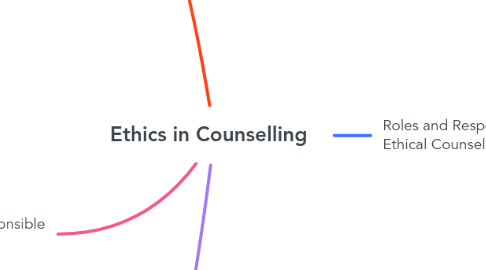
1. What are Ethics in Counselling?
1.1. What is morally right or wrong, dictate how we engage with others (Reeves & Bond, 2021; Proctor, 2014).
1.2. Informed by laws, professional standards, ethical codes and personal and cultural values (Bond, 2010; Finlay, 2019).
1.3. Ethics are not disconnected principles, separate to our therapy practice but are personal and professional values that influence all of our therapy practice (Finlay, 2019).
1.4. Tend to involve guidelines on using touch, dealing with risk and harm, consent, confidentiality, competence, valuing diversity and being mindful of dual relationships (Mcleod & Mcleod, 2011).
1.5. Helpful when counsellors need to figure out how to act on their own in a session, without access to an entire team to support decision making (Mcleod & Mcleod, 2011).
2. Who are counsellors responsible to?
2.1. Clients
2.2. Public (Jenkins, 2020; Mcleod & Mcleod, 2011).
2.3. Colleagues/Profession (Berdondini & Elton, 2020; Reeves & Bond, 2021)
2.4. Themselves (Mcleod & Mcleod, 2011)
3. My Personal Ethical Influences
3.1. Former boss
3.1.1. lack of confidentiality and support for colleagues. Ableism. Importance of self care and valuing diversity.
3.2. Former 'professionals'
3.2.1. dynamics of power and ability to take advantage of vulnerable clients for personal gain, importance of confidentiality
3.3. Current supervisor
3.3.1. self care, value of personal and professional development and referral
3.4. Lived experience of oppression and marginalisation
3.4.1. Valuing diversity, listening to clients lived experience, educating oneself on diversity and accessibility and putting clients first.
4. Roles and Responsibilities of the Ethical Counsellor
4.1. Reporter
4.1.1. Notify authorities of the abuse of a dependent (Avasthi et al., 2022)
4.1.2. Mandatory reporting is governed by law which varies based on location and counsellors must be familiar with the relevant laws in their area (Geldard et al., 2016).
4.1.2.1. eg. The ACT Insane Persons and Inebriates (Committal and Detention) Act 1936, The Children and Young Persons (Care and Protection) Act 1998 (Human Rights and Equal Opportunity Commission Sydney, 1992).
4.1.3. Recognising and addressing lack of fitness to practice in self and colleagues (Berdondini & Elton, 2020; Reeves & Bond, 2021).
4.1.3.1. Duty to report serious cases of ethical misconduct or unfitness to practice in colleagues (PACFA, 2017)
4.2. Learner and Supervisee
4.2.1. Personal and professional development and supervision (ACA, 2018; PACFA, 2017)
4.2.2. Therapists are required to be open and honest about their vulnerabilities in supervision (Barden & Caleb, 2020).
4.3. Information Keeper
4.3.1. Keeping the private information of clients a secret (Proctor, 2014).
4.3.2. Accurate information stored securely (digitally or in filing system) (Geldard et al., 2016; OAIC, n.d; PACFA, 2014).
4.3.3. maintain confidentiality and explain its limits (ACA)
4.3.3.1. Limit comes into effect if clients threaten safety of self/others and therapists should attempt to obtain consent from clients before disclosing their information. Court order for information to be shared or inaccessible to public (Jenkins, 2020).
4.3.4. Familiarity with local privacy laws, which govern the limits to confidentiality (Caudill & Kaplan, 2006).
4.3.4.1. Privacy Act 1988, The Health Records Information Privacy Act 2002 (HRIP Act), The Privacy and Personal Information Protection Act 1998 (PPIP Act), (Human Rights and Equal Opportunity Commission Sydney, 1992).
4.4. Boundary Navigator
4.4.1. Included in Professional Association Guidelines (Finlay, 2019).
4.4.1.1. avoiding dual/multiple and personal relationships with clients, former clients and their loved ones (PACFA, 2017).
4.4.1.2. No personal relationships with clients within 2 years of last counselling session (ACA, 2018).
4.4.2. “Boundary Rider”. Overlapping contexts are unavoidable and navigating dual relationships inevitable, so therapists make mindful decisions to ensure safety (Gabriel, 2009).
4.4.2.1. Sometimes dual relationships can be helpful (Finlay, 2019).
